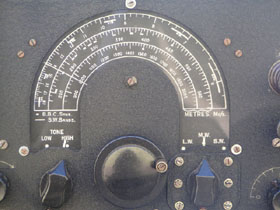General Description
It has also been claimed that it was often ealled an invasion receiver, as BBC frequencies were monitored continuously with it, where invasion warnings were to be broadcast.
There were 3 versions of the receiver, known as PCR, PCR2 and PCR3. These sets differed in frequency range and manufacturers. The PCR was produced by the Philips Lamp Co in the U.K., while later models appear to be the work of Pye. (U.K.) The first model was the only one with a loudspeaker inbuilt, electro-dynamic at that.

Technical Data
Band 1 16 - 54 metres
Band 2 244 - 550 metres
Band 3 844 - 2 5004 metres
The sets used WS#22 type metalwork, which was similar to that of the Australian 19 set. (The Australian 22 set is very different to that of the U.K. model. ) The set was supplied with either a 200-250v AC power pack or a l2 volt vibrator supply, remarkably similar to the No 22 supply.
The valve line up varied between models. The sets had an RF stage
(EF39), a Frequeney Changer (X61), 2 IF stages (EF39's), a Double Diode Triode ( EBC33) and an output stage which was either an EL32 or 6V6.

These sets formed the basis of a very cheap short wave receiver. They did not have a BFO, but they had plenty of room for an inbuilt power supply and BFO, with a "spare" valve hole already cut in the chassis.
They appear to have been quite popular. Although they do not appear to have been used by the Australian Army there are PCR's in Australia, obviously having been brought over by migrants.
